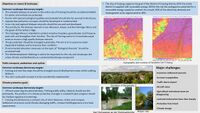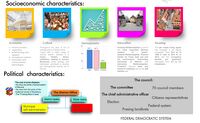LED2LEAP 2020 - Freising Team 5
>>>back to working groups overview
| Area | Freising | |
| Place | Freising and Munich Airport area | |
| Country | Germany | |
| Topics | Landscape Democracy | |
| Author(s) | Aida Kadic,Krishna Ambali Parambil,Imad Eddine Lallouche and Zareen Kashfee Prianka | |

| ||
Landscape Democracy Rationale
- This community context is relevant from a landscape democracy perspective because it is situated in a developed nation which is governed by democratic system and preserve the right of freedom of speech.It is also a basic social unit where there are many common aspects or attributes that makes it easier and effective context to have analysis on the landscape democracy.We can find out information about a particular space,their thoughts and needs about specific things and based on which we know how to mange green and urban areas.
- Our hypothesis is that from the challenge we have derived that the community of Freising is to a large extent familiar with the challenges they are facing and quite successful in stopping the things they don't support (e.g.the third runway of the airport).Community members are more concerned about the climate changes issues and have a futuristic vision.
Location and scope
- Map of Location
Phase A: Mapping our Community
The cityscape of Freising is shaped by the location of the city on the tertiary edge of the hill, to the south is Munich Gravel Plain, and extends north to the Tertiary hill country. The following striking elements shape the cityscape:
- The Domberg and the Weihenstephaner Berewry
- The green slopes
- The rivers
- Munich airport.
- The old town and the historic city and Town centers
- Neustift, Weihenstephan or Vötting
- the prince-bishop's residence
- A moderately growing population.
- Lower rate of unemployment and a thriving prospect.
- Multi-sources of income for the landkreis of freising.
- Breathtaking forests.
- Rich culture and diverse ethnicity.
- a beacon for scientists and future brewers.
- Reminiscent city with many historical landmarks
.
Groups of actors and stakeholders in our community
- Which groups/sub-communities are there? What are their needs and aspirations with regard to the landscape? Which groups are more visible? Which are less visible? What do we not know? (max 200 signs)
- Primary external stakeholders(Government bodies, moderators and decision makers)
- Private external stakeholders(Banks, Hotels, Private health institutions....)
- Community local stakeholders(landlords, farmers, investors,scientists......)
- Non profit internal stakeholders( churches, sports teams, parents groups....)
- Individuals(children, parents, disabled people....)
- the list of the Groups that are more visible includes( Officials, politicians, farmers, scientists,environment department representatives)
- Groups that are visible ( Investors,landlords, university, manufacturing organizations..)
- the remaining groups are less visible
- the needs and aspirations of the community: sustainable green city, reducing pollution and traffic jam, global warming issue and reducing co2 emission, airport noise, against the 3rd runway project of the airport.
- What we do not know:
- The strategies that has already been adopted to counteract wicked problems and the district's regulations.
- We also need to interact directly with people in order to have an in-depth understanding of the community
Relationships between our actors and groups
- How to describe the power relationship between the groups?
- Which groups may have shared interests and which are these?
- The council and the committees including the district administrative officer are the decision makers.
- the decision makers are elected by citizens.
- All community members have shared interests, skills and common challenges.
- Government officials and airport representatives have a common vision.
- Community members have a conflicting interests with local officials.
Summary of our learnings from the transnational discussion panel on April 22
- Different approaches about storytelling
- Some groups had a smaller scale focus areas but more detailed analysis.
- We loved the presentation styles from the other groups and we got inspired with new ideas.
- Other value schemes: any surprises?
- We had a lot of information so the comment was to highlight the most important points.
Theory reflection
- From The Right to The Landscape- we have encounter the idea of landscape having different meaning to different person. It is not only a goal or movement but it is also a context of combining socio-cultural and natural aspects with the spiritual prerequisite of individual and resulting into the both physical and spiritual welfare of them. It is formed by negotiating and influencing the public’s need and it is a combination of work of nature and man.
- From The Just City Essays- this material reflected that there is no boundary between people,and between landscapes.We should works as a whole with few philosophies such as equity, choice, access, innovation, ownership, etc. it makes us aware of that everyone’s decision is important as well as the democratic parties and we should not have any border or discrimination while designing as the place belong to the individual living there. So every voice should be count to make something livable.
- From the Storytelling, a model of and a model for planning- we have come across the process of how stories grow together and nurture the landscape planning and development. It shows how the old one follows the present and then the future like a chain of cycle and it is a process of time and hardship with commitment of previous stories. It reflected how a landscape can develop keeping the past essence and thinking of the future along with the needs of the present.
References
- References
https://archiv.ub.uni-heidelberg.de/propylaeumdok/498/1/06_09_rodier_et_al_urban.pdf, https://storymaps.arcgis.com/stories/dfa1ad422e8e49cf8293a7d0082d5d81 https://www.tripadvisor.com/LocationPhotoDirectLink-gi-Braustuberl_WeihenstephanFreising_Upper_Bavaria_Bavaria.html https://docs.google.com/forms/d/1lpQqRCZyAuTNvLm7RYwYWcy2L4TqW-nEf_Tcykfb04Q/edit?ts=5e9c5e36 https://storymaps.arcgis.com/stories/dfa1ad422e8e49cf8293a7d0082d5d81 https://weatherspark.com/y/70416/Average-Weather-in-Freising-Germany-Year-Round https://www.kreis-freising.de/englisch https://en.wikipedia.org/wiki/Freising_(district) http://www.icos-infrastruktur.de/en/icos-d/jahrestreffen/2019-freising/ https://www.greenaironline.com/news.php?viewStory https://www.freising.de/media/user_upload/61_Stadtplanung_Umwelt/6110_pdf-Files/STEP/stadtentwicklungsplan-step-2030-freising http://neighborhoodeconomics.org/community-stakeholders/
Phase B: Democratic Landscape Analysis and Assessment
The Scene in your Story of Analysis
- We already know that the third airport runway project was faced with a public outrage. Community members, activists, artists brought hands together, voted and protested all against this project so our main challenge is to reduce the shearing and the ever expanding gap between politicians and the locals.
- The second main challenge is to integrate immigrants, students and refugees with the local community through a participative initiative so as to know all community members aspirations and try to respond back and improve the landscape.
- Sharing values and taking advantage of community members’ skills and talents.Make the community more sensitive and aware about landscape issues.
- The physical scenes are the Marienplatz square, the Beer Garden, the weihenstephen university & the urban foodscapes.
- The socio-economic characteristics are Economy, Culture, Demography, Education & Housing.
- The political characteristics of the place are the council,70 council members, Citizens representatives,Fresing landkreis,& Federal system.
The Actors in your Story of Analysis
- In our story we won’t give any one a major role aside from farmers and landscape experts who would guide the community through the entire process.
- All the remaining members have the same roles and tasks so as to achieve social equality amongst all of them and enable them to walk in one another’s shoes. The less visible members in the community would also realize their importance and the fact that they are as equal to anyone in the group.
- add the corresponding visual from your presentation to the image gallery below
The Story of Analysis
- Describe the plot of the story and how it plays out.
- add the corresponding visual from your presentation to the image gallery below
- add as many additional images as you like
- Yourcase story2.jpg
add a caption
Reflect on your Story of Analysis
- How did the tools you chose for landscape analysis fit your community? Reflect on the questions: What did you carry? Why did you carry? How did you carry? What remains after you've left? (150 words)
- add the corresponding visual from your presentation to the image gallery below
- Yourcase refelction1.jpg
add a caption
Phase C: Collaborative Visioning and Goal Setting
* template coming
Phase D: Collaborative Design, Transformation and Planning
* template coming
Phase E: Collaborative Design, Transformation and Planning
* template coming
= Phase E: Collaborative Evaluation and Future Agendas * template coming
Process Reflection
- Reflect in your intercultural and interdisciplinary team on the outcomes of your study
- Which limitations were you facing?
- What have you learnt from each other?
- What would you do differently next time?
- You can also use diagrams/visuals
- 250 words text













